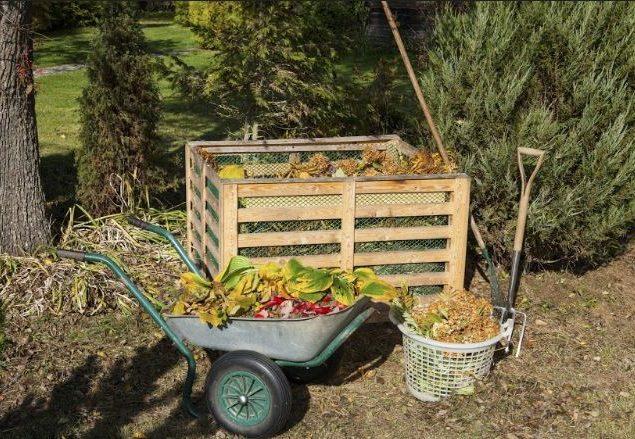The lawn plays a crucial role in boosting your home’s exterior appeal. For this reason, many homeowners have made it a priority. But it takes time and effort to make your garden more attractive, and in the process, it will accumulate garden waste such as branches, leaves and grass. The challenge now arises on what to do with this garden waste once you’re through decorating your yard.
Worry not as many homeowners also have this problem—you’re not alone. If you’re experiencing such a challenge, below is a clear outline of some of the ways you can properly carry out garden maintenance and green waste disposal.
1, Garden Skip Bins
If you don’t want the hassle involved with other garden waste disposal methods, then hiring a skip bin is the perfect solution. There are many larger and smaller companies that offer these services. Before choosing which company to go with, make sure to visit their website.
You’ll be given several days to fill it, which is five days in most cases. The best thing about hiring a waste management compost pickup company is that it’s a reliable and efficient way of dealing with your green waste.
When choosing the green waste skip dealer to go with, first make sure that their skip bin’s design meets your waste disposal needs. This is crucial because you don’t want skip bins that aren’t large enough to hold all your garden wastes. Reading the provider’s policy helps you confirm the limitations on the type of waste you can dispose of. This is important as only kitchen or domestic waste and green wastes are permitted to be disposed into the skip bin. However, wastes such as asbestos, defective electrical gadgets, plasterboard, and medical waste shouldn’t be added to the skip bin.
2, Composting
This is an efficient and eco-friendly way of disposing of garden waste. Because of this, it’s undoubtedly one of the best ways of dealing with this kind of waste. The composting process involves converting the waste material into compost. Waste from the kitchen or garden is converted into organic waste, which can be used in the garden later.
With that said, you shouldn’t compost all the garden waste. Therefore, you should go through the waste to separate the materials to be composted and those that won’t. The wastes to go into your compost pit include:
- Animal hair
- Pruned branches, tree barks, and twigs
- Grass, weed and leaves
- Old bedding plants
- Coffee grounds and tea bags
- Shredded paper and cardboard
- Kitchen wastes, for instance, vegetable peelings
- Vegetable and fruit scraps
- Clippings, unwanted plants and flowers
Although you can add kitchen waste, any meat or any food that could attract scavengers and pests are not advisable to include in the compost. Other items that should be disregarded from the compost are;
- Animal excrement
- Disposable nappies
- Charcoal
- Cigarette butts
- Dog and cat food
- Toxic materials
- Drink cartons
- Chemical logs
- Dairy products
- Infected plants
- Bone and hairy products
It’s important to follow the correct composting methods when disposing of your garden wastes. Otherwise, you’ll only get frustrated as your garden will stench with an unbearable smell. Here are the steps you should follow when composting the garden produce;
Step 1: Choose Your Preferred Compost Bin
There are two ways of managing your compost waste, and you choose either to use the combust bin and open pile. If you wish to preserve heat, keep out pests and maintain a cleaner looking garden. Combust bin is the ideal pick. You can get a combust bin from the garden shop or design one depending on the size of the garden waste.
Step 2: Pick The Ideal Spot
When choosing the best composting location, pick an area where it’s easy to add new ingredients or the spot where you can have minimal to zero difficulty taking out the compost.
Ideally, the compost bin should be placed on bare soil. This is recommended as it ensures optimal drainage system and a well-aerated compost. In addition, insects and microorganisms in the soil can easily enter the compost, thereby promoting it to rot faster. But if you choose to place the compost bin over a patio or concrete slab, make sure to place twigs or a layer of paper underneath it.
Step 3: Add The Right Components
You can also add other waste material into the compost other than garden waste, such as the kitchen waste material. However, always remove kitchen wastes such as cooked food and bones since this will attract pests.
Step 4: Layer The Waste Materials
Add the compost materials in layers. The first thing to add to the compost should be twigs as this ensures proper aeration and drainage, and then follow this up by adding a layer of leaves. After that, continue to alternately add carbon-rich brown materials and nitrogen-rich materials. The compost mix should ideally have 50-50 percent of the brown and green materials.
Never forget to add the brown material, or else the compost will become wet and take a longer duration to decay. Once you open pile or compost bin is full, make sure it’s properly covered for around six months.
3, Burning The Garden Waste
You can also eliminate green waste by burning it if you can’t access a waste management service and have no clue how composting is done. It’s an excellent way to dispose of hedge trimmings, twigs, weeds, and leaves. When burning the green waste, you can either use incinerators or bonfires.
However, you should only opt for this method if it’s allowed in your area as it has some downsides, including danger for wildlife and increased pollution. Please familiarize yourself with local laws before proceeding with the operation and burning of garbage in the yard. Only once you have the necessary permits and observe the laid down safety protocols should you proceed with burning the garden waste.
Burning green waste in incinerators is recommended instead of bonfires because they don’t produce as much smoke and burn at a higher temperature. With that said, bonfires are equally as effective but make sure it’s at least 50 feet from your house and 150 feet away from any of your neighbor’s homes. In addition, make sure to burn the waste on a calm, windless day and to closely monitor it the entire time to prevent the fire from getting out of control.
4, Reuse Or Recycle The Green Waste
If you’re into DIY, recycling or reusing the green waste instead of placing it in the skip bin or composting is another viable green waste disposal method. With the tree branches and twigs, you can design decorative items such as wreaths or use them for domestic purposes like lighting your grill. If you aren’t knowledgeable with DIY techniques, don’t dispose of the green waste as you can instead find someone else who’s into reusing and recycling. This way, the waste ends up making something beautiful and not getting destroyed.
There are also many ways you can use green wastes, such as chipped twigs, depending on what you wish. This includes using them in the greenhouse or for general homestead repairs.
5, Use Green Waste Bins
To cope with a huge volume of green waste, you can use green waste bins. This is an efficient way of doing away with the green waste despite being easy and cheap. Your local council will readily bring you this green waste bin upon your request. Once it’s delivered, all you need to do is fill it with green waste and wait for it to be collected on the scheduled days. The waste collected in the green waste bins will eventually be recycled.
After that, it’s then used by landscapers and in nurseries to create compost. But before this happens, the green waste first passes through several steps. This starts by sorting the waste by hand, passing it through grinders, covering it using a thermal material to prevent foul smell and later on heating to kill all the pathogens and pests. Consequently, it’s cleaned to get rid of all metal, graded and then made available for use in the lawn.
Now that you know what happens to the waste you place in the green waste bins, it’s your responsibility to add green and recyclable materials. This means excluding building materials, plastic bags, general rubbish and food scraps into the bins. The only acceptable waste to add is grass clippings, leaves, twigs, and flowers.
6, Drop Off The Green Waste At A Recycling Center
Unpleasant look of the green waste products on lawns isn’t visually pleasing. Due to this, homeowners may choose less environmentally friendly disposal methods such as throwing the green wastes into landfills. While doing this brings convenience and faster action, it’s not recommended due to its adverse environmental impact. In addition, this method is time-consuming and expensive. This is because you’ll need to collect the waste material and organize for transportation if you don’t own a vehicle that can do such a job. Therefore, you only get to spend more money in the process.
Fortunately, there’s a much better alternative. You can easily take the green waste at the recycling facility. Many of the local councils are nowadays either upgrading or introducing recycling centers in their regions. This move has seen a fall in the amount of waste that finds its way into landfills. There are no restrictions on how much green waste you can take at these centers, so you can choose to deliver either using your trailer or vehicle.
You don’t have to pay a penny when taking green waste to most recycling centers. These centers usually offer services for free. Nonetheless, others may expect or ask you to pay a small fee for your green waste disposal. Local councils also issue waste vouchers to taxpayers each year to encourage most households to dispose of green and general waste. The green waste you can take to the local recycling facility includes loose barks, weeds, grass clippings, palm fronds, and branches.
7, Use A Worm Bin
This method is somewhat similar to composting and entails the use of worms to break down the green waste such as grass clippings as well as food waste. And with worms playing such a crucial role in recycling soil nutrients, the use of these wiggly creatures isn’t a surprise. Worms perform the role of changing the soil minerals that are usually insoluble into a form that plants can absorb.
It would be best if you placed the worm bin close to your kitchen since worms are also effective at breaking down kitchen scraps and different food-based organic material. This bin also should be in an area that isn’t too cold or too hot. To ensure the overall condition of worms is guaranteed, make sure to get some kind of fibrous material.
8, Rent A Dumpster
Renting out a dumpster is an ideal way to ensure you have a convenient way to dispose of your green waste for as long as you want. The advantage of this green waste disposal method is that it is fairly straightforward. If you’re not well-versed with some of the complex green waste disposal methods, such as composting or using the worm bin, this is great news.
Should you choose to rent a dumpster, make sure first to assess that it fits your needs. It’s advisable you do this to avoid a scenario whereby it gets filled quickly hence not meeting your needs. But before getting a dumpster, make sure first to confirm whether having a dumpster is permitted in your area. If approved, you have a quick and convenient way of removing waste on your lawn without breaking a sweat.
Takeaway
While garden waste such as plant clippings and grass cuttings are biodegradable, knowing how to dispose them of properly can be relatively challenging. This is one area that many homeowners end up failing even after following all environment-friendly steps. But after going through this informative guide, this shouldn’t be an issue again as you can now have some of the information on how to dispose of your green garden waster properly.










